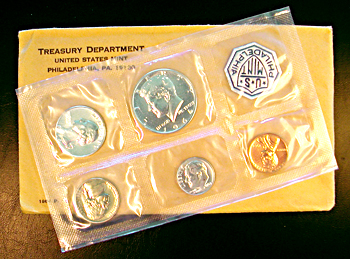|
"Making Cents"
The Signal
Saturday, September 16, 2006
| T |
While visiting my sister and nephews in Philadelphia, I noted that the local bank at Cheltingham was offering rolls of the new coins when the bank opened that day. When I arrived, a long line outside the bank greeted me. I decided to wait my turn. When I reached the teller's window, I bought two $10 rolls of the new coins so I could bring them back to my coin club in Whittier for the members to buy. Since P-mint coins were always hard to find, this was a golden opportunity. The bank manager greeted the crowd and said he had never seen such a rush for a new coin issue. (Of course, he wasn't around in August 1909 when the Lincoln cent was issued).
In August 1964, prices for the 1964 proof sets rose rapidly to about $30 per set, from an issue price of $2.10. I was slated to speak to the North Bay Coin Club in Richmond one evening, and when I arrived, it was standing-room-only.
I thought the advance notice of my talk brought out the entire membership of the club. After the coin business was out of the way, the club drew for the door prize, which after several weeks had grown to ten 1964 proof sets (which had a value of almost $300 at the time). When the lucky member's name was drawn and he gleefully accepted his booty, the crowd thinned to perhaps 20 people. The other 175 or so vanished into the night.
I was honored with the presence of the famous Walter Breen, who lived nearby in Berkeley. I gave my talk anyway — and was rewarded with a 1964 proof set and a certificate.
In an unprecedented move, the director of the Mint announced that the demand for the 1964 proof set had exceed the initial production limit, so the Mint would issue an additional million or more new sets at $2.10 to people who had not previously ordered sets. The price fell overnight to about $3.50.
Since it was evident that 1964 would be the last year of 90-percent silver coins, the price of 1964 and earlier sets began to rise once again in anticipation of the rise in silver prices.
Large quantities of hoarded Morgan dollars from the Treasury vaults were coming on the market at the same time. I sold several Brilliant Uncirculated rolls of New Orleans Mint issues to the Downey Coin Club for door prizes at $24 a roll.
They had a prize system called "The Silver Dollar Board." The slots were filled at each meeting with silver dollars, and door prizes were drawn for these coins. For several years, I managed to furnish the club with many rolls at these bargain prices — BU coins only. We actually would spend circulated silver dollars at face value!
For those who ventured into the desert and Las Vegas in 1964, there wasn't much there except the Stardust, the Hacienda, and a handful of similar hotels and casinos. However, many of the dollar slot machines dispensed real silver dollars (almost all of them common, circulated dates). The casinos managed to cull out the Carson City Mint coins and certain scarcer dates.
At one coin show in 1964 at the Sahara, Stan Zuraski, a noted Las Vegas dealer, was selling Morgan dollars for $9.90 per 10 coins. He had hundreds on his table and they were not moving very fast. I took an 1895 proof set (including the rare silver dollar) on consignment for $1,500 from dealer Joel Rettew and sold it to a doctor who liked nicer coins. I made $50. That set would bring about $35,000 today, or more.
A strange phenomenon occurred that year: The 1950-D nickel was touted as a great investment coin, since so few ever seemed to be found in change and no one knew of any great hoards hidden away. Prices rose to $30 per coin. A few years later, many rolls came on the market and prices plunged as low as $4 per coin. Still, very few seemed to get into circulation.
Gold coins did not seem to cause much excitement, since the Gold Act of 1933 was still in force and no one wanted to buy gold coins, even though collector coins were exempt from confiscation. It turned out that no one had gold coins confiscated as a result of the act. Dealers were offering $20 gold pieces for as low as $25 per coin for used specimens. I even saw an older, low-grade Liberty Head $20 pocket piece for sale for just $21.
Coin clubs were energized by the new coins and the excitement over the 1964 proof sets. As president of the Whittier Coin Club, I saw membership boost by 50 in one year and double in three years.
A former student of mine at Sierra High School in Whittier, class of 1964, located me recently through a Google search and said he remembered when I took him and a few classmates to the monthly meetings of the Whittier Coin Club. He still has some coins and asked if I'd be interested in them.
Yep, he has some of those 1964 Kennedy halves I brought back from Philadelphia more than 40 years ago. Too bad he didn't put away all those uncirculated Morgan dollars I offered for several months at $1.25 a piece.
It was a very special year, indeed.
Dr. Sol Taylor of Sherman Oaks is president of the Society of Lincoln Cent Collectors and author of The Standard Guide to the Lincoln Cent. Click here for ordering information.
©2006, THE SIGNAL · ALL RIGHTS RESERVED.

![[Most Recent Quotes from www.kitco.com]](http://www.kitconet.com/images/quotes_special.gif)

